The Samsung Galaxy S10+ Snapdragon & Exynos Review: Almost Perfect, Yet So Flawed
by Andrei Frumusanu on March 29, 2019 9:00 AM ESTInference Performance: APIs, Where Art Thou?
Having covered the new CPU complexes of both new Exynos and Snapdragon SoCs, up next is the new generation neural processing engines in each chip.
The Snapdragon 855 brings big performance improvements to the table thanks to a doubling of the HVX units inside the Hexagon 690 DSP. The HVX units in the last two generations of Snapdragon chips were the IP blocks who took the brunt of new integer neural network inferencing work, an area the IP is specifically adept at.
The new tensor accelerator inside of the Hexagon 690 was shown off by Qualcomm at the preview event back in January. Unfortunately one of the issues with the new block is that currently it’s only accessible through Qualcomm’s own SDK tools, and currently doesn’t offer acceleration for NNAPI workloads until later in the year with Android Q.
Looking at a compatibility matrix between what kind of different workloads are able to be accelerated by various hardware block in NNAPI reveals are quite sad state of things:
| NNAPI SoC Block Usage Estimates | |||
| SoC \ Model Type | INT8 | FP16 | FP32 |
| Exynos 9820 | GPU | GPU | GPU |
| Exynos 9810 | GPU? | GPU | CPU |
| Snapdragon 855 | DSP | GPU | GPU |
| Snapdragon 845 | DSP | GPU | GPU |
| Kirin 980 | GPU? | NPU | CPU |
What stands out in particular is Samsung’s new Exynos 9820 chipset. Even though the SoC promises to come with an NPU that on paper is extremely powerful, the software side of things make it as if the block wouldn’t exist. Currently Samsung doesn’t publicly offer even a proprietary SDK for the new NPU, much less NNAPI drivers. I’ve been told that Samsung looks to address this later in the year, but how exactly the Galaxy S10 will profit from new functionality in the future is quite unclear.
For Qualcomm, as the HVX units are integer only, this means only quantised INT8 inference models are able to be accelerated by the block, with FP16 and FP32 acceleration falling back what should be GPU acceleration. It’s to be noted my matrix here could be wrong as we’re dealing with abstraction layers and depending on the model features required the drivers could run models on different IP blocks.
Finally, HiSilicon’s Kirin 980 currently only offers NNAPI acceleration for FP16 models for the NPU, with INT8 and FP32 models falling back to the CPU as the device are seemingly not using Arm’s NNAPI drivers for the Mali GPU, or at least not taking advantage of INT8 acceleration ine the same way Samsung's GPU drivers.
Before we even get to the benchmark figures, it’s clear that the results will be a mess with various SoCs performing quite differently depending on the workload.
For the benchmark, we’re using a brand-new version of Andrey Ignatov’s AI-Benchmark, namely the just released version 3.0. The new version tunes the models as well as introducing a new Pro-Mode that most interestingly now is able to measure sustained throughput inference performance. This latter point is important as we can have very different performance figures between one-shot inferences and back-to-back inferences. In the former case, software and DVFS can vastly overshadow the actual performance capability of the hardware as in many cases we’re dealing with timings in the 10’s or 100’s of milliseconds.
Going forward we’ll be taking advantage of the new benchmark’s flexibility and posting both instantaneous single inference times as well sequential throughput inference times; better showcasing and separating the impact of software and hardware capabilities.
There’s a lot of data here, so for the sake of brevity I’ll simply put up all the results up and we’ll go over the general analysis at the end:
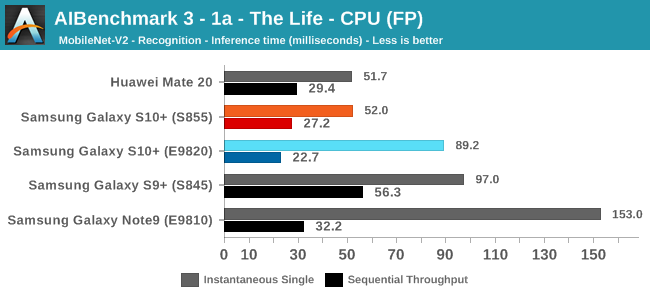
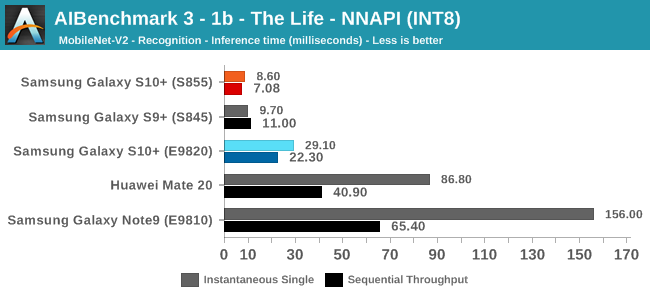
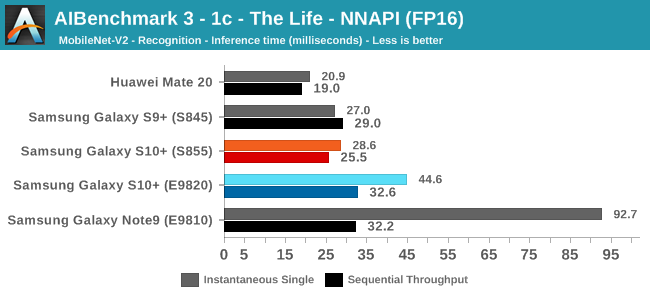

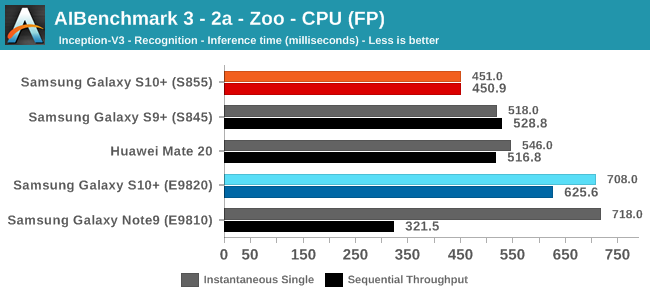
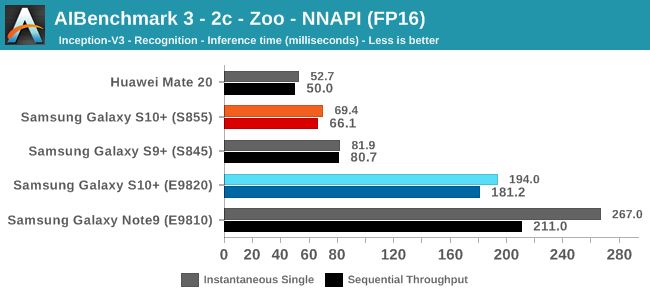
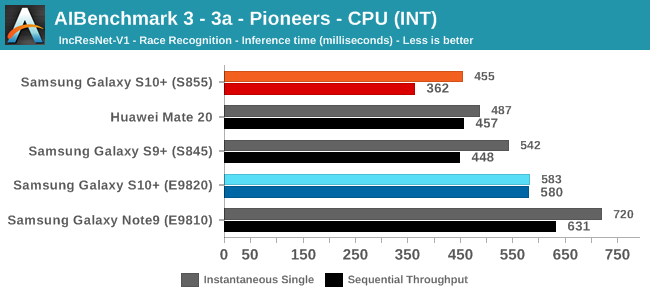
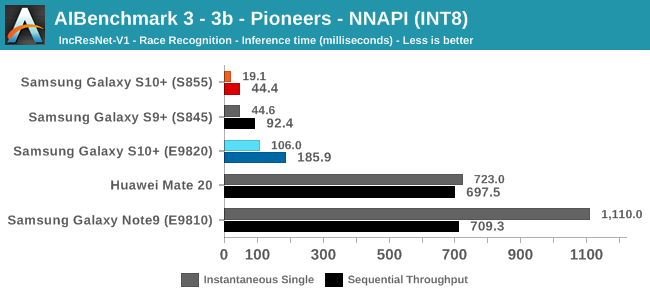
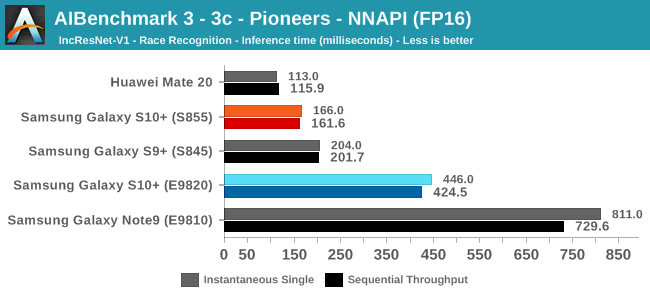

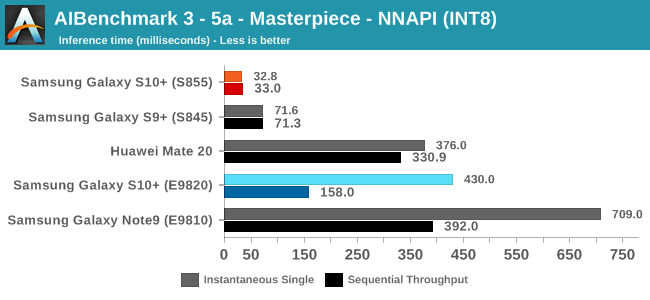
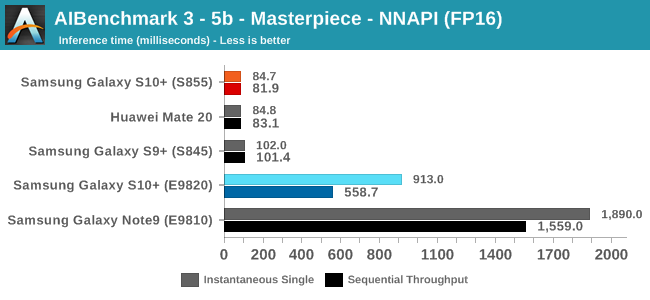
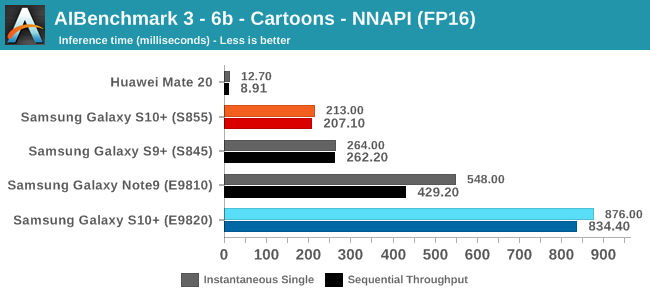






As initially predicted, the results are extremely spread across all the SoCs.
The new tests also include workloads that are solely using TensorFlow libraries on the CPU, so the results not only showcase NNAPI accelerator offloading but can also serve as a CPU benchmark.
In the CPU-only tests, we see the Snapdragon 855 and Exynos 9820 being in the lead, however there’s a notable difference between the two when it comes to their instantaneous vs sequential performance. The Snapdragon 855 is able to post significantly better single inference figures than the Exynos, although the latter catches up in longer duration workloads. Inherently this is a software characteristic difference between the two chips as although Samsung has improved scheduler responsiveness in the new chip, it still lags behind the Qualcomm variant.
In INT8 workloads there is no contest as Qualcomm is far ahead of the competition in NNAPI benchmarks simply due to the fact that they’re the only vendor being able to offload this to an actual accelerator. Samsung’s Exynos 9820 performance here actually has also drastically improved thanks to the new Mali G76’s new INT8 dot-product instructions. It’s odd that the same GPU in the Kirin 980 doesn’t show the same improvements, which could be due to not up-to-date Arm GPU NNAPI drives on the Mate 20.
The FP16 performance crown many times goes to the Kirin 980 NPU, but in some workloads it seems as if they fall back to the GPU, and in those cases Qualcomm’s GPU clearly has the lead.
Finally for FP32 workloads it’s again the Qualcomm GPU which takes an undisputed lead in performance.
Overall, machine inferencing performance today is an absolute mess. In all the chaos though Qualcomm seems to be the only SoC supplier that is able to deliver consistently good performance, and its software stack is clearly the best. Things will evolve over the coming months, and it will be interesting to see what Samsung will be able to achieve in regards to their custom SDK and NNAPI for the Exynos NPU, but much like Huawei’s Kirin NPU it’s all just marketing until we actually see the software deliver on the hardware capabilities, something which may take longer than the actual first year active lifespan of the new hardware.










229 Comments
View All Comments
Azurael - Saturday, March 30, 2019 - link
"the M4 cores should very much be quite a lot more efficiency than the A75 cores"*brain explodes*
Samus - Sunday, March 31, 2019 - link
They should have gone with a pop-out camera than the hole punch. Hate to say it but apples notch was the best solution other than a pop-up camera.Javert89 - Sunday, March 31, 2019 - link
Just a precisation. Adreno 640 do not have 50% more execution units, indeed it should be the usual 2 core design seen in the 630.. only the Adreno of the bigger Snapdragon 8cx has 3 cores plus a 128 bit memory controllerAndrei Frumusanu - Sunday, March 31, 2019 - link
It *does* have 50% more execution units / ALUs; https://images.anandtech.com/doci/13680/Screenshot...bjtags - Sunday, March 31, 2019 - link
Huawei Mate SE 99% of this for 1/4 the Price.....s.yu - Monday, April 1, 2019 - link
Entirely laughable.tipoo - Sunday, March 31, 2019 - link
The efficiency + performance of the A12 even in comparison to this continues to be crazy, and we're on the other side of the year of that launching.I'd be really interested to see that put against x86 cores in SPEC2006
name99 - Monday, April 1, 2019 - link
Here you are. Not a PERFECT comparison but the best currently available:https://www.anandtech.com/show/13392/the-iphone-xs...
https://www.anandtech.com/show/11544/intel-skylake...
Would be great if we had comparison graphs, and if it were compiler to compiler (both LLVM) and if it were desktop cores, and if it were Coffee Lake, and ...
But as I said it's the best available right now.
Basically (especially if Apple adds SVE to their desktop ARM core) they probably have nothing to fear in terms of reduced performance by switching to the A12 successor.
s.yu - Monday, April 1, 2019 - link
I gotta say I'm surprised from the first sample that the S9+ was the best among the Samsung's and very, very close to Pixel performance which is still overall No.1, S10PS only comes second, S10PE is about as bad as the Note9, I think some of these have defective lenses with especially bad resolution on the edge(s)...the difference is much smaller in the center of the frame. So it could be said that even with the f/2.4 aperture, the Samsung's lens has QC issues that aren't masked. It would be interesting to see how P30P's f/1.6 lens fares.S9+ didn't stand out so much in the HDR scenes though, but from the landscapes I'd say the S9+ probably got an especially good lens sample, better than the S10PS and much better than the S10PE. How the Pixel reproduces texture is just incredible, though many of the scenes are rendered darker, there's little sign of the crushed black issue, i.e. it's just darker, but high quality, it's still my definition of realistic among almost any smartphone output, it would obviously stand better to sharpening or NR in post.
Regarding the wide shots...HDR's the differential. The S10PS outperformed the Mate20P despite a wider FoV in most of the landscape samples, but failed to do so in the shot under the bridge.
IMO in low light shots the PS still wins overall, to the PE, PE seems to have issues mapping black (with minimal actual shadow advantage) while in the midtones as both win in certain instances it's a toss. Still nothing beats the Pixel...Mate20P's auto was especially bad in the maintenance center shot, that was interesting considering the sensor size.
And I have to disagree just from the first night sample that the PS isn't matching Mate20P's night mode, it's evident that it did a poor job on the sand, but *everything else* on the frame is better, the subject, the houses in the background, the light posts. It is clear in the second night mode shot with a low DR range though, that the Samsung's messed up.
lty0432 - Monday, April 1, 2019 - link
Hi author !I think this kind of technical articles on Exynos and SD has been best out there.
Can I possible get your opinion on how mobile processors stack up against PC processors ?
Are there any benchmark comparison articles ?